June 18, 2025 | 22:12 GMT +7
June 18, 2025 | 22:12 GMT +7
Hotline: 0913.378.918
June 18, 2025 | 22:12 GMT +7
Hotline: 0913.378.918
In India, people grow Azolla in tarpaulin tanks placed on barren plots of land that cannot be cultivated or arranged in many layers and still meet the protein needs of livestock and poultry of farmers at low cost. Vietnam previously had the V.A.C circular agriculture model proposed by Professor Tu Giay, which has been effective.
Azolla in India is a constituent part of the modern V.A.C model. Farmers can use cow manure to fertilize Azolla, and Azolla can be used as food for cows, chickens and fish, and also provide fertilizer for vegetables and rice.
Currently, in some industrialized countries, people have models of Azolla Biosystem and Azolla Biohub. These systems allow the creation of optimal conditions for Azolla's year-round growth and reproduction for large-scale production.
The outputs of Azolla biological systems are products as diverse as fertilizers, fodder, pharmaceuticals, biofuels, or simply CO2 absorption. These systems can be formed outdoors naturally or installed indoors with a multi-storey structure, using LED lighting and automatic irrigation, drainage, and fertilization.
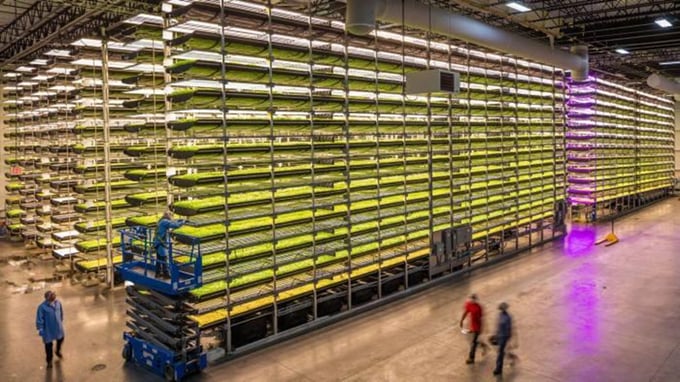
Aerofarms' highly automated vertical farming system.
Currently, scientists are testing hybrid Azolla varieties that can absorb up to 60-70 tons of CO2/ha/year. From the amount of CO2 absorbed by Azolla, it is possible to calculate the amount of oxygen that Azolla releases into the air to help improve the living environment. Simultaneously with CO2 absorption, Azolla also fixes nitrogen in the air, producing about 800 - 1,200 kg of plant protein/ha/year for the field.
According to studies, each hectare of Azolla can absorb 2,587 kg of CO2/year (when the CO2 concentration reaches 338ppm of normal air), which is eight times higher than a hectare of forest and 32 times of a hectare of natural grass. The higher the CO2 concentration, the more Azolla can absorb, specifically at 1,000ppm, Azolla will absorb 4,460kg CO2/ha/year, and at 1,600ppm, Azolla will absorb 6,569 kg CO2/ha/year.
Azolla's corpse helps to loosen the soil, so it restores the growth of shrimp, fish... and waterfowl in rice fields. Thanks to its distinct genetics, Azolla's ability to fix nitrogen from the air is three times higher than other legumes.
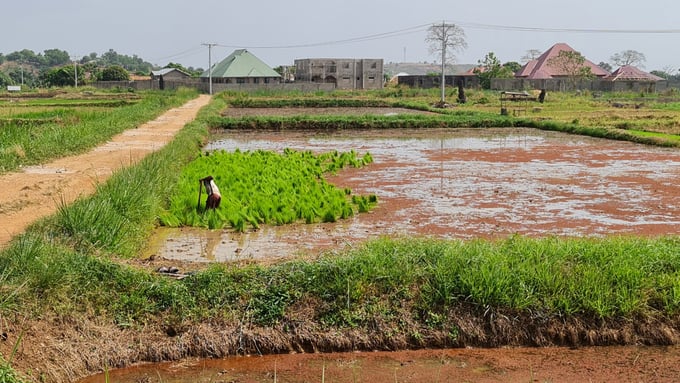
Azolla in Africa.
Assuming that Vietnam has 4 million hectares of wet rice with 2 crops/year and 4 months of vacant land, Azolla will be released to absorb about 10 million tons of CO2/year and emit over 7.2 million tons of O2. This amount of greenhouse gas is equivalent to the CO2 absorption capacity of 32 million hectares of forest - an area Vietnam cannot have. With 4.8 million tons of natural nitrogen applied to the field, the soil becomes porous and fertile, restoring the microflora needed for plants in the following years.
Tiny organisms living in water fields, such as shrimps, shrimps, fish, snails, etc., as food for humans and waterfowl, help restore the balance of the natural ecosystem, which is absent from birds and shrimps, indirectly serve the eco-tourism industry, gradually reduce the process of pollution of domestic water sources. Farmers can reduce the cost of fertilizer and animal feed by at least 20%.
At the macro level, with the numbers, although it is only an estimate of the amount of CO2 absorbed annually along with the benefits of fertilizers and environmental improvement, it is clear that Vietnam can fully meet its commitments, reducing greenhouse gas emissions in agriculture at COP 26. Vietnam needs to have appropriate solutions in terms of techniques, technology, and a form of arrangements:
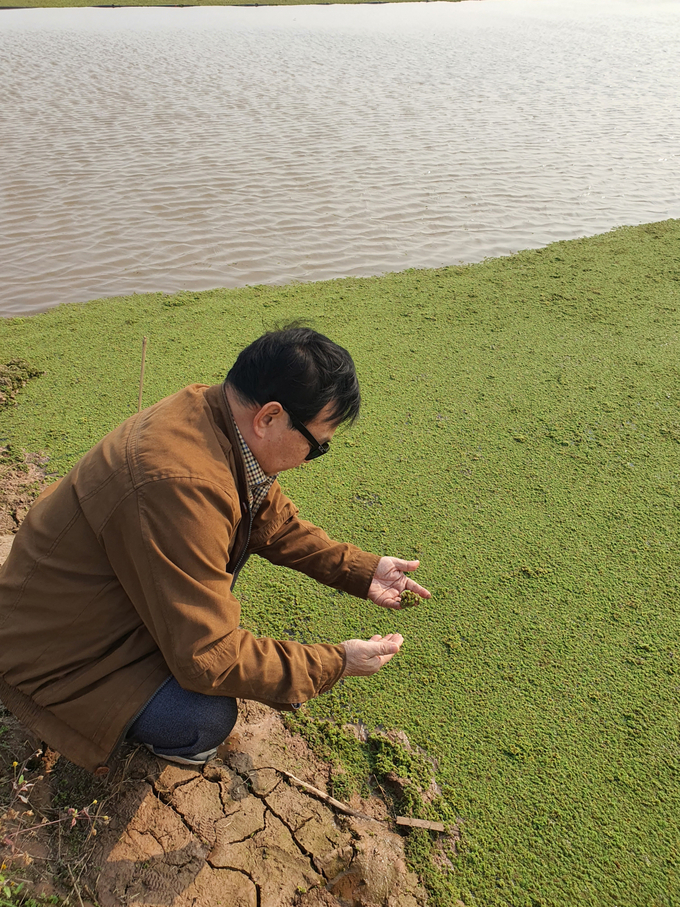
Dr. Pham Gia Minh is in the field of Azolla.
Regarding technique and technology: It is necessary to synthesize lessons from folk experiences and scientific findings on Azolla farming in Vietnam and around the world to form a rich library of Azolla.
An example is the secret to keeping Azolla varieties through the hot season by growing Azolla on mud rafts and dropping them on the pond under the shade of the sun (popularized by Nguyen Cong Tieu in Science Magazine in March 1935) or how to incubate Azolla to deep-root, a deadly fungus that his father had successfully applied;
Application of microbiological technology, such as beneficial bacteria in producing products from Azolla such as fertilizers, substrates and animal feed. Collect native Azolla varieties, selectively introduce and create hybrid ones with heat tolerance, salt tolerance, and high yield, and build a gene pool for long-term research.

Model of Azolla growing as medicinal herbs in Thai Binh province. Photo: Duong Dinh Tuong.
Regarding the form of arrangements: There should be companies that specialize in farming and trading Azolla to provide seeds and planting materials, construction consultancy and operation services for modern, deep-processing Azolla biological systems to bring to the market for high-value-added products. Besides large-scale farming, small-scale farming should still be maintained, and households using Azolla will follow the V.A.C model as long as it is effective.
The hydropower industry, especially in the Northern Delta, must adjust the discharge schedule appropriately to facilitate rice cultivation with Azolla; develop standards for carbon credits in Azolla farming and a policy to encourage farmers similar to afforestation...
Vietnam can propose UNESCO recognize Azolla as a tangible heritage of wet rice culture based on recent recognition by international scholars that Vietnam is the first country to have a scientific foundation for combining Azolla farming with wet rice cultivation.
Translated by Ha Phuc
/2025/06/17/3942-2-143243_548.jpg)
(VAN) Recently, in Sweden, the Secretary of the Binh Dinh Provincial Party Committee presented the Investment Registration Certificate for the 'Polyester Fabric Recycling Complex' project to SYRE Impact-AB Company.
/2025/06/12/3721-2-202745_83.jpg)
(VAN) TH made an impression at Seoul Food 2025 with its line of natural beverages, paving the way for Vietnamese food products to enter the South Korean market.
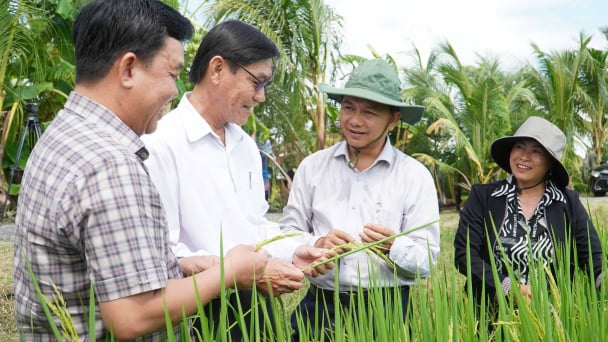
(VAN) Soc Trang's success in rice exports stems from a strategy of developing fragrant and specialty rice cultivation areas and standardizing production toward low-emission practices.
/2025/06/11/1311-5-120811_839.jpg)
(VAN) The pig farming industry is facing the challenge of comprehensive restructuring to meet requirements for quality, safety, traceability, and market expansion both domestically and for export.
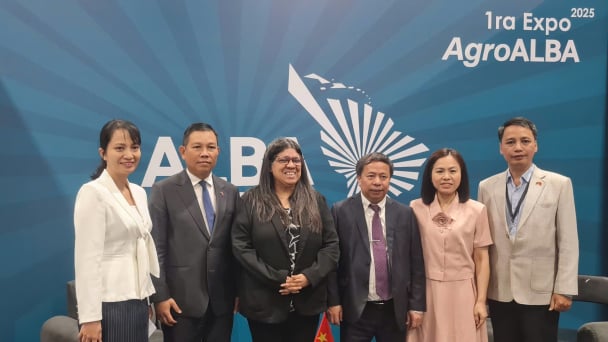
(VAN) Vietnam considers participating in ALGROALBA in order to expand agricultural production, coordinate the assessment and effective exploitation potential land.
/2025/06/05/5314-1-184727_407.jpg)
(VAN) From seemingly worthless fish scales and skin, enzymes and lactic ferments can transform by-products into peptides, opening a sustainable, effective business direction and elevating Vietnamese seafood.
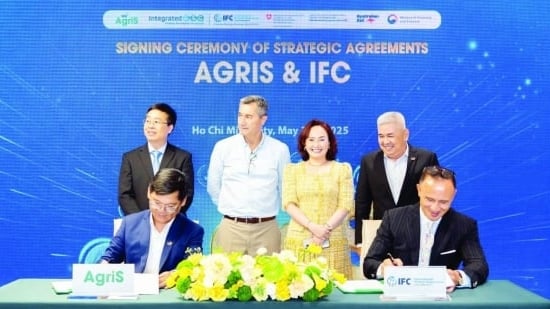
(VAN) TTC AgriS and IFC signed a strategic partnership to develop a sustainable agricultural value chain, aiming to achieve the Net Zero target by 2035.